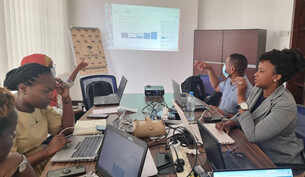1 . Introduction
1.1 Background
In Tanzania, routine health data are mostly generated and collected at the service provision level i.e., health facility, and at the end of each period such as weekly or monthly, health services providers summarize them in aggregate summary forms for reporting purposes. The District Health Information Software 2 (DHIS2) is the endorsed platform by the Ministry of Health, Community Development, Gender, Elderly and Children (MoHCDGEC) for collating and processing routine health information collected from the service provision level. Since 2014, the platform is used nationwide at the district council level as well as in some health facilities with optimum infrastructure.
1.2. Data Quality Challenges
The MoHCDGEC and its stakeholders understand the value of using quality and timely data in decision making to ultimately strengthen the health system. Despite this, the quality of collected and reported data was reported with low quality with glaring contrast between the data reported in various stages of the routine data collection cycle . The lack of quality data renders the credibility of information generated from the DHIS2 platform into question and may discourage the use of information for policy decision making. For consistent information to occur, health data need to be of high quality so that users are confident that the information they are consulting are accurate, complete, and timely.
Recognizing the need for improving the quality of collected data in its national Health Information System (HIS), the MoHCDGEC deployed DHIS2 Data Quality Packages. The Data Quality Packages facilitates rapid screening of data to identify the most important missing data and the most suspicious values. The package aligns with the WHO Data Quality Review framework for routine information systems .
2 .The Intervention
In collaboration with her technical partners such as HISP Tanzania and the University of Dar es Salaam (UDSM), the MoHCDGEC deployed DHIS2 Data Quality (DQ) packages which includes DQ dashboards and WHO DQ application in its national HIS. The DQ Dashboards identify data quality problems in the collected data and consolidate them in the dashboards. The DQ dashboard is visible as soon as the user logs into DHIS2, facilitating quick access to the data quality challenges facing the collected routine data. The DQ dashboards were developed by HISP Tanzania with the support from the WHO. On the other hand, the WHO DQ application is an automated tool for rapidly screening data to identify the most important missing data and the most suspicious values. The application is a DHIS2 application designed by WHO and Health Information System Programme (HISP) network following the WHO Data Quality Review framework for routine information systems.


Figure 1: DHIS2 Data Quality Packages
The MoHCDGEC conducted a national Training of Trainers (ToT) to build capacity of its staff to conduct cascading training in the sub-national levels. The ToT was conducted with the facilitation from WHO, UDSM and HISP Tanzania with participants from the national level and selected regions. Following the ToT, a pilot in two regions namely Tanga and Dar es Salaam was used to test the packages used at the subnational levels i.e., regional and district level, whereby both tools were found very useful. Guidelines on data quality dashboards were also developed by HISP Tanzania to facilitate peer learning while back in their sites.
3 . Impacts of using DHIS2 Data Quality Packages on Tanzania national HIS
The DHIS2 DQ packages facilitate data managers at national and sub-national levels in addressing data quality issues in routine health information such as identifying the most important missing data and the most suspicious values. The packages cultivate “data culture” by triggering actions from the data managers on the erroneous values identified by the package. Furthermore, MoHCDGEC can monitor programs performance and improve service delivery through the trends displayed by the dashboards. Apart from service delivery, the MoHCDGEC can also form an accurate picture of health needs, programs, and services in specific areas, as well as allocate and use resources effectively and efficiently.
The DHIS2 DQ packages piloted and tested in two regions received positive feedback; Users hailed the use of the package as it analyses the data and visualizes the data which required attention with the dashboards. One interview said, “this tool will make our life easier, now we can view all issues of data in one place”.


Figure 2: Participants using DHIS2 Data Quality Packages
With the use of DHIS2 DQ packages, there has been an improvement on the quality of the collected data. The WHO data quality tool has been used in the National HIS since 2016, and was recently upgraded and complemented with a Data Quality dashboard to strengthen efforts towards high data quality. This aligned with the Health Basket Fund Independent Verification Report 2015/2016 that noted an improvement of data quality from 46% up to 93.7% and average error rate decreased from 56% to 6.7% in year 2015 to 2020 respectively. The quality improvement was attributed due to the interventions used across time including DQ tools as observed in pilot regions. .
4 . Going forward
With low quality data, demand for data drops leading to limited information use within the health system. The MoHCDGEC is now focusing on building capacity of its health personnel on improving the quality and analysis of the health information. Scaling up the DHIS2 Data Quality Packages nationwide and at different levels i.e region, district council and health facilities is top of its priorities list. Also, broadening the scope of the digital packages to include other programmes that were not included in the beginning, as well as making them more generic. The intervention is expected to strengthen the national HIS by improving the quality of the data and its demand leading to improved data-informed decision making.